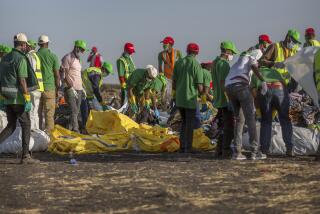Lawsuit Alleges $20 Billion in Stealth Fraud : Defense: Unsealed court papers claim that Northrop overcharged the government for the B-2 bomber from the word go.
- Share via
Five former employees of Northrop Corp. and one man who still works there asserted in a lawsuit unsealed Monday in U.S. District Court in Los Angeles that the company has overcharged the government by about $20 billion on the B-2 Stealth bomber program.
U.S. District Judge Mariana R. Pfaelzer unsealed an amended complaint in the suit, which adds many new charges and includes new plaintiffs.
The basic thrust of the amended complaint is that Northrop’s entire performance on the B-2 has been riddled with fraud from its initial work and that it has used a host of methods to overcharge the government.
These include giving the government falsified progress reports on its production of the B-2, submitting false data on the amount of money spent to perform work on the B-2, mischarging labor costs, submitting false vouchers for the purchase and procurement of parts and materials and knowingly misrepresenting the progress made in the production and engineering status of “a crucial electronics system called ZSR-62,” which is a classified system, according to the plaintiff’s lawyers, Herbert Hafif and Philip Benson of Claremont.
The original suit, filed in February, 1988, contained 17 counts alleging fraud and asserted that there were $2 billion of overcharges. The amended complaint, filed Monday, has 44 counts alleging fraud and contends that there have been $20 billion in overcharges. The suit does not give a detailed explanation of how the $20-billion figure was compiled.
The suit was filed under the federal False Claims Act, a statute which allows private citizens to file suits on behalf of the government and share in any damages that the government ultimately recovers. The statute provides that the government has 60 days to decide whether it will intervene in a False Claims action and allows the government to take over any such suit, though the original plaintiffs are permitted to retain an active role in the case.
In November, 1988, the Justice Department announced that it had declined to intervene in this case. Assistant Atty. Gen. John R. Bolton said that after a review and investigation of the plaintiffs’ allegations, the department decided “that there is not a sufficient basis for it to enter the case at this time.” The government could still intervene in the case after reviewing the new allegations.
Northrop spokesman Tony Cantafio said Monday that the Beverly Hills-based company had just received the amended complaint and thus could not comment on it. He would only say, “the last time these people attacked us on the B-2 the government spent eight months investigating and found that there was ‘not a sufficient basis’ for government action. The B-2 is meeting its flight test objectives.”
The plaintiffs include Jean-Francois Truong, a former controller overseeing manufacturing technology on the B-2; Curtis Dane, an avionics engineer who worked in the B-2’s final assembly plant in Palmdale; Terrence Schielke, a former senior auditor at Northrop; Eugene Ottaviano, a former manager of the electronic data processing audit department on the B-2; Richard P. Sylvester, a lawyer and engineer, who is a former strategic analyst on the B-2 program, and Richard Croswell, a former manager of engineering technology at Northrop.
The suit also contains separate allegations that Schielke was unlawfully demoted after raising questions about fraudulent activity on the B-2 and that all of the other plaintiffs were unlawfully discharged from Northrop after raising objections about the alleged fraud.
The Air Force plans to build 132 Stealth bombers, a plane that is designed to evade enemy radar through a combination of new and sophisticated technologies. The Air Force said in July that it plans to spend $70 billion during the next decade to buy the 132 planes.
The company has been under considerable heat in Congress for delays in producing the plane and cost overruns. In court papers filed Monday, the plaintiffs assert that Northrop has garnered $23 billion from the government for its work on the program so far and that $5 billion of that sum is cost overruns.
One of the most striking allegations in the amended complaint is that Northrop, after devising a highly sophisticated computerized conveyor for fabricating wire harness systems, took the system apart and used a 20- to 30-year-old technology to fabricate the wire harness assemblies. The suit alleges that Northrop did this because an examination of the sophisticated system would have revealed to the Air Force excessive cost and management system problems that were “causing chaos and confusion throughout the B-2 program.”
More to Read
Inside the business of entertainment
The Wide Shot brings you news, analysis and insights on everything from streaming wars to production — and what it all means for the future.
You may occasionally receive promotional content from the Los Angeles Times.










